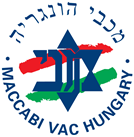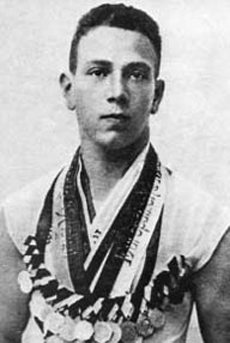Famous Jewish athletes and sports leaders
in Hungary

Every week, Maccabi VAC presents a Hungarian Jewish athlete, sports leader, pruner, coach, who played a decisive role in Hungarian and universal sports.
Alfred HAJÓS
(1878-1955)
 Two-time Olympic champion swimmer, footballer, architect, sports manager.
Two-time Olympic champion swimmer, footballer, architect, sports manager.
Hajos was born into a poor Jewish family in Budapest, living with his father, Jakab Guttmann, and mother Rozália Löwy. After graduating from the Budapest University of Technology and Economics, he worked in the office of Ignác Alpár and then with Ödön Lechner. In 1907 he opened an independent office. He successfully participated in multiple grants. He initially designed in Art Nouveau, then eclectic, later a modern, constructive style. Like several members of the contemporary youth, he was also active in sports. At the 1896 Summer Olympics (the first modern Olympics) in Athens, in seawater measuring at 13 ° C, he won both the 100 meter (1: 22.2) race and the 1,200 meter (18: 22,1) in which he swam from the boat to the shore with which he won the first and second Olympic victory of Hungarian sports (not a gold medal, since at that time the winners only received a silver medal). In 1895 he was the unofficial European 100 meters champion fondly titled as the “eternal Hungarian champion”. As an athlete, he participated in gymnastics in addition to swimming (1896–1898), while also exercising and playing football at an outstanding level. In recognition of his physical fitness, his skills were showcased in the forward position of the football matches.
On May 9, 1897, he played in the first football match of the Budapest Torna Club (BTC). He played in the BTC between 1898 and 1904. In 1901 and 1902 he was a member of the championship team. He later also worked as a football referee and coach.
The building of the Subotica branch of the Hungarian General Credit Bank, the grammar schools of Levoča and Kőszeg, and the Institute for the Blind opened in Cluj-Napoca and Szombathely were built on the basis of Hajós’ architectural plans. His most famous work in the period before 1920 was the Golden Bull Hotel.
In the Horthy era, Hajós had already designed mainly sports facilities, and his Art Nouveau and eclectic style features were replaced by modern forms in his work. In 1922, based on his blueprints, the 20,000-seat stadium in Újpest was built as well as the associated sports complex on Megyeri road. The former Olympic champion also brought to life his dream of the Margaret Island Sports Pool, now known as the Alfréd Hajós National Sports Swimming Pool, but many other spaces such as the Millenaris Park and the Győr Swimming Pool also bear his mark. Together with Dezső Lauber, he submitted a project for the art competition of the Paris Olympics in 1924, which was later awarded a silver medal by the committee.





